SW Boatworks
An Evolving Downeast Tradition
by Kelli Park
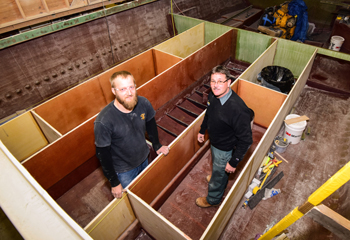
I-Beams and deck installation on a 44' Calvin Beal lobster boat. Black fuel tanks, lower left of above photo, with fuel lines running through protective gray conduit. Decking is composite panels glued and mechanically fastened down.
Over the past century, the maritime tradition of boatbuilding has evolved with an ebb and flow that parallels the changing tides. Despite inevitable challenges and changes that occur within the industry, the economy, and society, SW Boatworks has found its niche within Maine’s maritime culture as the sole builder of Calvin Beals Jr. and Young Brothers designs, and continues to thrive, one boat at a time.
Stewart Workman has been around boats his entire life. Growing up on the water in Prospect Harbor, Workman’s earliest memories involve the working waterfront, whether he was fishing with the “old timers” or hauling his own traps. Workman pursued his interest in boats on a variety of levels; he was first introduced to boatbuilding while working for Young Brothers and then spent four years in the Coast Guard on the Great Lakes, the West Coast, and in Alaska. Workman returned periodically to lobstering, but eventually his creativity got the best of him. Boatbuilding was in his future and SW Boatworks was underway.
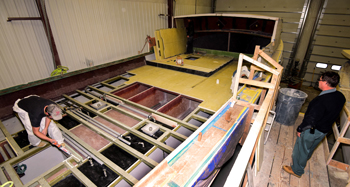
Gleason Smith left, Team Leader, and Stewart Workman working on fuel tank areas in a 44' Calvin Beal. Photo includes area of the bilge structure, fuel tank and fish hold compartments. Kelli Park photos.
“We’re creating something from nothing. The materials come in a drum in a tractor-trailer; they start out in liquid form. We’re building the hull and we’re finishing the whole thing. . .You can build a dozen lobster boats and they’re all going to be different,” explains Workman.
Timing is everything, when it comes to the evolution of SW Boatworks. Workman began gradually by finishing boats in the winter, when lobstering slowed down. In 1999, he and a friend, who happened to be looking for a space, began working together to finish boats; as they picked up more work, they eventually went their separate ways. Within two years, Workman expanded to two workshops and hired additional crew to meet the demands of the workflow. Workman began inquiring about the possibility of laying up hulls for his friend, Calvin Beal, whose family has been building lobster boats in Maine since the early 1900s. In 2007, Workman happened to be in the right place at the right time when Beal agreed to sell him his molds, making SW Boatworks the exclusive builder of the Calvin Beal. SW Boatworks began building hulls and tops for the Calvin Beal, which range in size from 30' to 50' and can be designed as lobster boats, sport fishing boats, and yachts. Despite the recession that started in 2008, the popularity of the Calvin Beal allowed SW Boatworks to stay in business, one boat at a time. “We were lucky that it all pulled together that way. It’s been well worth it…We’ve been really happy to carry on Calvin’s tradition. I couldn’t ask for a better person to do business with.”
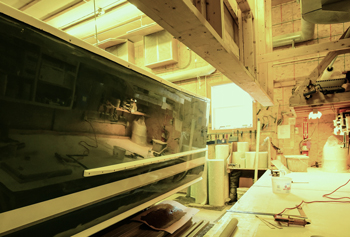
Rails installed on a 44' Calvin Beal. Lifting rails and quarter guards being installed. The finish is a high gloss gelcoat. Color is Stars and Stripes Blue.
One year later, another golden opportunity presented itself to SW Boatworks in the form of the Young Brothers molds. The Young Brothers business, including many of the tools, the molds, the workshops and the property in Corea, was for sale and Workman seriously considered buying; after much deliberation, Workman decided not to relocate from Lamoine, where he had spent nine years establishing his business. The additional distance for customers and crew to travel to Corea, as well as the added expense of transporting materials to a more remote location, were major factors in Workman’s decision. Good fortune found him again, however, when he received a call from the new owner of the molds. Workman purchased the Young Brothers molds, making SW Boatworks the only builder of the fastest lobster boat on the water, and has since built a variety of models ranging from 33' to 45'. After less than ten years in business, SW Boatworks now had the exclusive rights to build both Calvin Beal and Young Brothers boats.
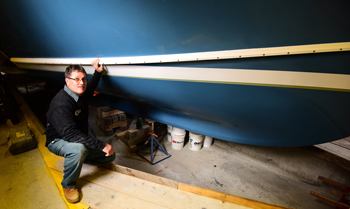
Stewart Workman doing a spray rail inspection on a 44' Calvin Beal. Spray rail product is 1258R PVC, glued, mechanically fastened and glassed over on the inside. Soon to be bottom painted. Kelli Park photos.
In the decade since SW Boatworks acquired the molds, business has evolved and grown with the changing industry. The crew consists of fifteen local, full-time boatbuilders who have learned the in’s and out’s of the trade in the workshops of SW Boatworks; they spend their time building hulls and tops, finishing boats, and lengthening hulls. The majority of hulls and tops are built for commercial fishermen from Massachusetts to Downeast Maine, although the Calvin Beal and Young Brothers models are now being marketed as sportfishing boats and yachts as well. The duration of each job varies greatly; most lobster boats are complete within six months, whereas a high-end yacht can take up to two years. On average, SW Boatworks builds four to six boats each year – from hull to finish – and receives orders from as far as Alaska and Key West. Current projects include: two 44' Calvin Beal offshore lobster boats, a 36' Calvin Beal sportfishing boat, a 30' Calvin Beal lobster boat, a 45' Young Brothers lobster boat, and a 44' Calvin Beal being lengthened to a 48'. In 2017, Workman developed a new model, which has met with great success; he took a 38' Calvin Beal, cut it in two and stretched it to make a 42'. Recent projects show the diverse nature of the business and include marine patrol boats, research boats, and law enforcement boats. In the past two decades, SW Boatworks has built over 130 boats, 29 of which are the new 42' Calvin Beal.
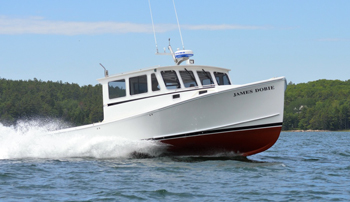
34' Calvin Beal lobster-style boat. The James Dobie, is a working fishing vessel in Scituate Harbor, MA.
SW Boatworks is known for building rugged, high-quality boats that withstand the test of time. Despite the challenges that present themselves, including the increasing cost of materials, the lobster catch, bait expenses, finding and keeping crew, and building a quality product, SW Boatworks plans to keep the boatbuilding tradition alive in Downeast Maine. The boatbuilders at SW Boatworks learn something new everyday and hope to share their knowledge with the next generation to sustain Maine’s maritime culture. SW Boatworks shows what it means to be defined by a living tradition in times that change like the tides.
“It’s a good feeling to know that we’re still building Downeast lobster boats. . .Hopefully there’ll be a new run of young people who want to get into this. Keep our fingers crossed.”
